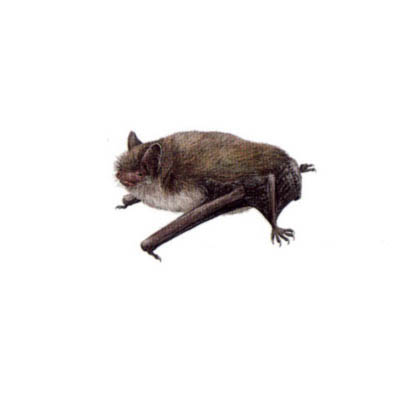Daubenton's bat

Myotis daubentonii (Kuhl, 1819)
Vespertilionidae
Least Concern
| Other names | |
|---|---|
| Catalan | Rater d'aigua |
| Spanish | Murciélago ratonero ribereño |
| English | Daubenton's bat |
| French | Murin De Daubenton |
| Basque | Daubenton saguzar |
| Galician | Morcego das ribeiras |
Description
The smallest of the trawling bats, smaller than the long-fingered bat (Myotis capaccinii) and the pond bat (Myotis dasycneme), with a body length of 45 to 55 mm, a weight ranging between 6 and 10 g, a forearm length of 33 to 42 mm, and a tail length of 20 to 50 mm. The hind legs are characteristically large and covered with sensitive hairs, measuring between 9 and 11 mm. The dorsal fur is gray or brown, while the ventral side is usually lighter, with juveniles being darker than adults. The wing membrane has a dark, brown, or gray color. The ears are short, triangular in shape, measuring between 9 and 14 mm, with the characteristic pointed tragus of the Myotis genus, which is quite short and usually light-colored, ending with a black tip.
Fotografies
Distribution
This species is found throughout Europe, although with a more fragmented distribution in the Mediterranean region, where it is limited to mountainous areas. It is absent in some islands such as Sicily or the Balearic Islands. Its distribution limit extends to the south of the Scandinavian Peninsula and the north of Finland, and to the north of Turkey, the Caucasus, reaching to the east of Russia, Mongolia, Korea, and the northern part of Japan.
Roosts and phenology
The roosts are typically located near watercourses in riparian forests or in structures like bridges or human buildings. Maternity colonies can be found in tree hollows or bat boxes, although they may also inhabit rock crevices or, more rarely, abandoned buildings. Maternity colonies in underground shelters are rare. These are usually formed in late spring and can include anywhere from 20-50 females to as many as 600. Maternity roosts can vary widely, and colonies have been observed moving between 40 different tree hollows. During the breeding season, males are often found at higher altitudes, while maternity colonies are near water bodies at lower elevations, where prey is more abundant. Females give birth to pups between mid-June and July. Juveniles typically start flying around 3 or 4 weeks after birth, and some juveniles reach sexual maturity in their first autumn (though not all).
Between August and September, these animals gather during the nights in caves and mines in a behavior known as "swarming," where individuals from many different colonies come together at specific locations to mate. It is considered a non-migratory species, but it undergoes movements of about 150 km between maternity and hibernation roosts, with recorded maximums of 300 km. Lowland populations tend to make longer movements than those in higher elevations. In winter, they typically hibernate in caves and mines, with maximum aggregations of up to 20,000 individuals recorded in Poland.
Habitat and diet
It is an adaptable species, primarily associated with aquatic environments and forest habitats, although it can also be found near urban areas. Most individuals hunt over water, but solitary animals can also be found in forests, urban areas such as parks, as well as gardens or meadows. In the Mediterranean region, it is often found in the upper reaches of rivers and small bodies of water. It is common in rocky and cliff areas up to 1,400 m in altitude.
The diet is quite opportunistic, hunting small insects (less than 7.2 mm), mainly diptera, hymenoptera, hemiptera, and lepidoptera, as well as occasionally small fish. This species typically hunts about 5-40 cm above water surfaces with a fast and agile flight, a behavior known as "trawling." Prey is captured directly from the water with its specially adapted large feet and uropatagium. This species prefers calm and less turbulent waters. Solitary individuals may hunt in flooded forests or meadows. They usually hunt within a distance of 6-15 km from their roost.
Echolocation
Its echolocation is characteristic of the Myotis genus. It typically emits modulated calls lasting about 3-7 ms, starting at high frequencies between 60-90 kHz and ending near 30 kHz. The frequency of maximum energy is usually between 40-50 kHz. Its calls often exhibit a slight "s" shape. Like many members of the Myotis genus, it is acoustically classified as Myotis 50.
Trends
| General trend | Stable |
|---|---|
| Protocol | ChiroRivers |
| Geographic scope | Catalonia |
| Number of localities studied | 52 |
| Annual change | -0.2 % |
| Method | TRIM |
| Analysis execution date | 01/09/2024 |
Status
According to the IUCN Red List, it is considered Least Concern, with a stable population trend. This species is protected by national laws in various countries, as well as by the Eurobats Agreement, the Bern Convention, and the European Habitats and Species Directive. The species is common throughout its distribution, and some studies have shown that the population is increasing across its range.





